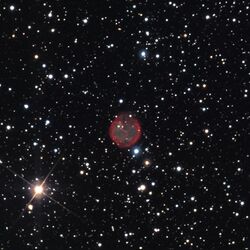Astronomy:NGC 7048
From HandWiki
Short description: Planetary nebula in the constellation Cygnus
| Emission nebula | |
|---|---|
| Planetary nebula | |
 | |
| Observation data: J2000 epoch | |
| Right ascension | 21h 14m 15.25s[1] |
| Declination | +46° 17′ 16.1″[1] |
| Distance | 5260 ly (1613[2] pc) |
| Apparent magnitude (V) | 12.1[3] |
| Apparent diameter | 1.02′ |
| Constellation | Cygnus |
| Designations | PK 088-01 1, PN ARO 41, IRAS 21124+4604 |
NGC 7048 is a planetary nebula in the constellation of Cygnus. The bright star to the lower left of the nebula is a magnitude 10.5 star, designated TYC 3589-4652-1. The nebula is slightly brighter along the west and east sides.[4] This planetary nebula has an apparent magnitude of 12.1.[3] NGC 7048 was discovered by Édouard Stephan on 19 October 1878 using a 31.5-inch reflector.[5]
The central star of NGC 7048 is thought to be a white dwarf. The planetary nebula itself has an elliptical shape; from its low surface brightness it is thought to be highly evolved.[4]
References
- ↑ 1.0 1.1 "NGC 7048". https://simbad.u-strasbg.fr/simbad/sim-id?Ident=%4062765&Name=NGC%20%207048.
- ↑ Stanghellini, Letizia; Shaw, Richard A.; Villaver, Eva (2008). "The Magellanic Cloud Calibration of the Galactic Planetary Nebula Distance Scale". The Astrophysical Journal 689 (1): 194–202. doi:10.1086/592395. Bibcode: 2008ApJ...689..194S.
- ↑ 3.0 3.1 "Revised NGC Data for NGC 7048 - Hartmut Frommert - SEDS". http://spider.seds.org/ngc/revngcic.cgi?NGC7048.
- ↑ 4.0 4.1 Davis, Christopher J.; Smith, Michael D.; Stern, Luke; Kerr, Thomas H.; Chiar, Jean E. (2003). "Near-infrared spectroscopy of (proto)-planetary nebulae: Molecular hydrogen excitation as an evolutionary tracer". Monthly Notices of the Royal Astronomical Society 344 (1): 262–282. doi:10.1046/j.1365-8711.2003.06820.x. Bibcode: 2003MNRAS.344..262D.
- ↑ Seligman, Courtney. "New General Catalogue objects: NGC 7000 - 7049". http://cseligman.com/text/atlas/ngc70.htm#7048.
External links
 |

